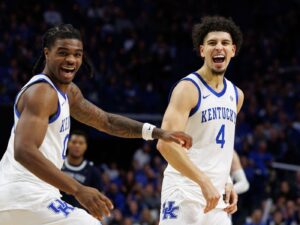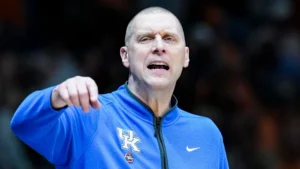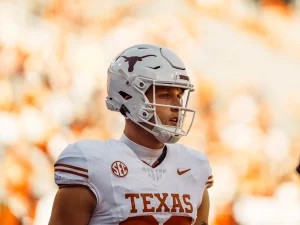
RETURNING? Why Otega Oweh WILL Come Back For Kentucky Basketball | Kentucky Wildcats Podcast
In a time where the transfer portal turns over rosters faster than ever and name, image, and likeness (NIL) deals blur the lines between pro and college decisions, it’s rare to find a player with both elite upside and unfinished business opting to stay rather than bolt. But as the Kentucky Wildcats reload under head coach Mark Pope, one high-profile transfer appears primed not only to thrive in Lexington — but potentially to return in 2026 for a second run in blue and white.
That player? Otega Oweh.
The former Oklahoma Sooner and explosive two-way guard transferred to Kentucky during the 2024 offseason, joining Pope’s new-look Wildcats with eyes on taking a leap into national prominence. A 6-foot-5 athletic marvel with a 6-foot-10 wingspan, Oweh is built like an NBA shooting guard and has flashed tantalizing potential on both ends of the floor. But while some Kentucky fans may assume he’s a one-year rental en route to the draft, there’s a growing belief — both inside the program and among those close to Oweh — that he could return for a second season in Lexington.
And honestly? That might be the best decision he could make — for himself, for Pope’s team, and for Kentucky basketball’s national title hopes.
Let’s break down why Oweh will come back for the 2025–26 season — and what that could mean for the Wildcats.
Part 1: The Talent Is Undeniable — But So Is the Room for Growth
Oweh’s physical tools are the kind that make NBA scouts salivate. At 6’5”, he possesses elite lateral quickness, a strong upper body, and a motor that never turns off. He can guard three positions, finish above the rim in transition, and routinely makes hustle plays that don’t show up on the stat sheet.
At Oklahoma last season, he averaged 11.4 points, 3.8 rebounds, and 1.5 steals per game while shooting 47% from the field. He was the team’s top perimeter defender and its emotional leader — a tough, tenacious guard who made winning plays.
But he also attempted just 48 three-pointers on the year — making only 14 of them (29.2%). His offensive game is still raw, particularly in the half-court. While he can beat defenders off the dribble and finish with authority, his jumper lacks consistency, and he’s not yet an advanced passer or pick-and-roll creator.
NBA evaluators love Oweh’s tools — but many view him as a project. He’s not currently projected in most 2025 mock drafts. And with the influx of talent in upcoming draft classes, he could be overlooked if he declares too early.
That’s where the case for staying another year becomes so compelling.
Part 2: Mark Pope’s System Could Unlock His Full Potential
If there’s a coach in college basketball poised to elevate Oweh’s offensive game, it’s Mark Pope.
Pope’s offense emphasizes spacing, movement, and ball reversals. It’s less reliant on isolation and more about creating scoring opportunities through flow and teamwork. That bodes well for a player like Oweh, who thrives when the ball doesn’t stick and when he can make instinctive plays rather than forced reads.
Pope also places a premium on player development. At BYU, he turned mid-major talents into all-conference performers and even NBA hopefuls. His staff’s commitment to skill development — particularly shooting mechanics and decision-making — is already being felt in Kentucky’s early summer workouts.
In Pope’s system, Oweh won’t be asked to carry the scoring load. He’ll be empowered to attack closeouts, cut without the ball, defend the opposing team’s best perimeter threat, and gradually expand his offensive repertoire. That type of structured role could allow him to flourish and build toward a breakout second season where he showcases a more complete game.
If Oweh improves his shooting and adds more polish to his handle, there’s no reason he can’t go from a fringe draft name to a legitimate first-round prospect by 2026.
Part 3: NIL, Comfort, and the New Age of Staying Put
Five years ago, a player like Oweh would’ve had little incentive to stay an extra season. If the NBA wasn’t calling, the G League or overseas opportunities likely would be. But in 2025, with NIL opportunities at powerhouse programs like Kentucky, there’s no financial rush to go pro.
According to sources familiar with Kentucky’s NIL infrastructure, Oweh is already positioned to make six figures this season through brand deals, merchandise sales, and Wildcat-focused collectives. If he returns for 2026 — especially if he elevates his profile with improved play — those numbers could grow significantly.
Beyond the money, there’s also the element of comfort and loyalty.
Oweh has spoken glowingly about his decision to come to Kentucky, particularly about Pope’s vision and the culture shift in Lexington. The Wildcats’ coaching staff has embraced him as a core piece of the team’s future, not just a short-term solution. That mutual trust could be critical.
And unlike many players who bounce from school to school in search of touches or clout, Oweh seems to appreciate stability. After two seasons at Oklahoma, he chose Kentucky not because it was flashy, but because it was the right fit. If that fit continues to feel right, why wouldn’t he return for one more shot?
Part 4: A Crowded 2025 Draft and Better Timing in 2026
Let’s look at the 2025 NBA Draft.
It’s expected to feature a loaded group of guards and wings, including Bronny James (whose profile skyrocketed after a strong sophomore year), Tyrese Proctor, Ja’Kobe Walter, and several international standouts.
Even if Oweh takes a big leap this season, he’d likely be competing for a second-round spot — at best.
But in 2026? The path is far clearer. Many of the top 2025 draft-eligible guards will be off to the league, and the 2026 class is currently seen as a “reset” year — less top-heavy and more fluid.
If Oweh returns, adds a midrange pull-up, improves his three-point shot to around 35%, and becomes an All-SEC defender, he will be drafted. And possibly in the top 30.
That long-term planning makes sense. Rushing to the pros only to get stashed overseas or waived in training camp is a risk Oweh doesn’t have to take. He’s playing at Kentucky — he’s in the spotlight already.
Why gamble now when the house is in your favor if you wait?
Part 5: Kentucky’s 2026 Title Hopes May Hinge on His Return
From Kentucky’s perspective, Oweh’s return would be a monumental win.
Assuming some roster turnover in 2025, Pope’s team will still have talented young pieces but will need veteran leadership and defensive tone-setters. Oweh fits that bill perfectly.
He could serve as the 2026 version of what DeAndre Liggins was to Calipari’s early Kentucky teams — a gritty, high-IQ, defensive monster who sets the standard every possession.
Moreover, his return would offer continuity — something Kentucky has sorely lacked in recent years. If Oweh stays, he could become the emotional leader and on-court glue that holds a championship roster together.
Pope knows this. The coaching staff is already mapping out long-term plans for Oweh, hoping to make Lexington a home for more than one year.
Part 6: The Fans Already Love Him — Imagine Year Two
There’s something about the way Otega Oweh plays that just fits at Kentucky.
He doesn’t complain. He doesn’t take plays off. He plays like every possession matters.
And Big Blue Nation has noticed.
Fans are already buzzing about Oweh’s potential impact this season. The comparisons to former UK greats like Keith Bogans or Michael Kidd-Gilchrist aren’t thrown around lightly — but when you watch Oweh fly in for a putback dunk or hound a guard 94 feet, you start to see it.
Now imagine what Year 2 could look like:
- Oweh averaging 15+ points per game.
- Shooting 35–38% from three.
- Guarding the opposing team’s best scorer every night.
- Leading Kentucky to the Final Four with a veteran core around him.
It’s not a pipe dream. It’s a legitimate possibility — if he stays.
The Right Move for Oweh Is the One That Builds Legacy
It’s easy to get caught up in the race to the NBA. Players are told from the moment they enter high school that the clock is ticking. That if you’re not in the league by age 21, you’re behind.
But players like Otega Oweh prove that timing matters more than speed. That growth matters more than hype.
In Kentucky, he has the rare opportunity to be more than just a name on a roster — he has the chance to be a legacy.
If he stays, he can etch his name into Wildcat lore alongside players who stayed, developed, and won — guys like Tayshaun Prince, Darius Miller, or even Willie Cauley-Stein. He can be part of something bigger than himself. Something lasting.
And if we’re betting today?
Otega Oweh will come back for Kentucky basketball. And when he does, he’ll help lead them on a run that Big Blue Nation will talk about for years to come.





